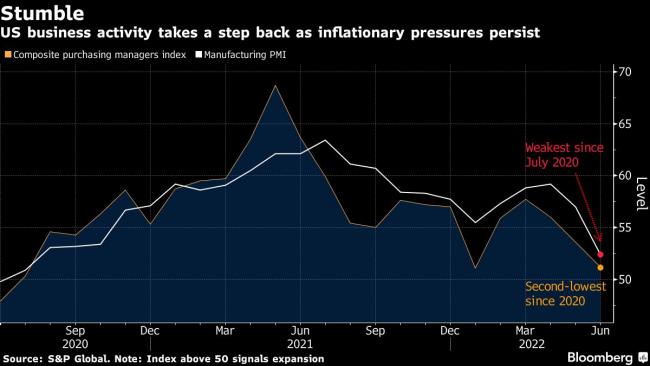(Bloomberg) -- US business activity took a decisive step back in June as rapid inflation reduced demand for services and led to outright contractions in factory orders and production.
The S&P Global (NYSE:SPGI) flash June composite purchasing managers index slid 2.4 points to 51.2, the group reported Thursday. While still above 50, and therefore indicating growth, the reading was the second weakest since July 2020, when the economy was clawing its way out of a pandemic-induced recession.
Businesses also downgraded their expectations about the economy’s prospects in the coming year against a backdrop of high inflation, rising interest rates, slower demand and lingering supply-chain concerns.
The group’s measure of services registered the slowest pace of expansion since the start of the year, when the Omicron strain of the coronavirus stifled activity. A gauge of new business in those industries contracted for the first time since 2020.
“The survey data are consistent with the economy expanding at an annualized rate of less than 1% in June, with the goods-producing sector already in decline and the vast service sector slowing sharply,” Chris Williamson, chief business economist at S&P Global Market Intelligence, said in a statement.
After a burst of activity as pandemic restrictions eased, “firms are now seeing households increasingly struggle with the rising cost of living, with producers of non-essential goods seeing a similar drop in orders,” Williamson said.
Results from Europe were similar. An indicator for euro-area economic activity fell to a 16-month low, while manufacturing output declined for the first time in two years.
In US manufacturing, growth slowed abruptly with the S&P Global index dropping 4.5 points to 52.4 in June, one of the largest monthly declines in data back to 2007. Production swung from solid growth last month to contraction in June as high prices, weaker demand and materials shortages combined to push the output index to a two-year low.
Manufacturers’ concerns about inflation, rising interest rates and logistics resulted in the weakest expectations for production since October 2020.
While the S&P Global composite index of input prices fell to a five-month low, it remained well above levels seen prior to April 2021. Besides high fuel, food, transportation and material costs, firms “often mentioned” that wage increases to retain workers were contributing to operating expenses, according to the report.
The group’s composite gauge of employment showed the slowest growth in four months.
Survey data were collected June 13-22, which included the Federal Reserve’s most-recent policy meeting in which central bankers raised the benchmark interest rate by the most since 1994.
“Business confidence is now at a level which would typically herald an economic downturn, adding to the risk of recession,” Williamson said.
(Adds graphic)
©2022 Bloomberg L.P.

